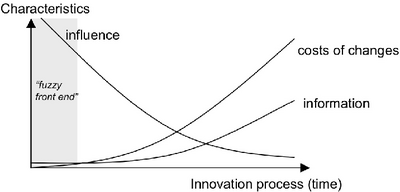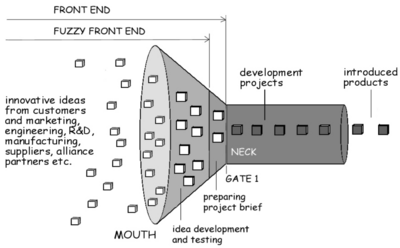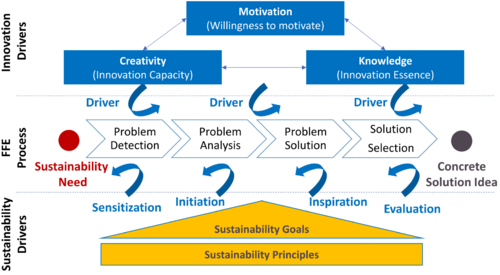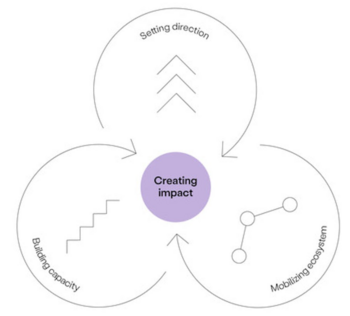Front-end Sustainability: Initiating the right sustainable projects
(→3. Open up to external collaborative innovation) |
|||
| (4 intermediate revisions by one user not shown) | |||
| Line 59: | Line 59: | ||
-------- | -------- | ||
===3. Open up to external collaborative innovation=== | ===3. Open up to external collaborative innovation=== | ||
| + | [[File:MissionDrivenInnovation.png|350px|thumb|right|Mission Driven Innovation framework by the Danish Design Center<ref name=Mision/>]] | ||
The next step to true sustainability impact of projects, programs and portfolios is working collaboratively across organizations, as the scope of the long-term, complex and systemic sustainability challenges is beyond what a single organization, government or individual can solve alone <ref name=Bason2023/>. Approaches include '''stakeholder involvement in sustainability innovation'''<ref name=Juntunen2019>Juntunen, Jouni K., Minna Halme, Angelina Korsunova, and Risto Rajala. 2019. “Strategies for Integrating Stakeholders into Sustainability Innovation: A Configurational Perspective.” Journal of Product Innovation Management 36(3):331–55.</ref>, '''[http://wiki.doing-projects.org/index.php/Logical_Framework_Approach_in_Project_Planning Logical Framework LFA]''', '''Open Innovation'''<ref name=Sherwin2017/>. This article will focus on an emerging approach, that is gaining increasing support; Mission Driven Innovation. | The next step to true sustainability impact of projects, programs and portfolios is working collaboratively across organizations, as the scope of the long-term, complex and systemic sustainability challenges is beyond what a single organization, government or individual can solve alone <ref name=Bason2023/>. Approaches include '''stakeholder involvement in sustainability innovation'''<ref name=Juntunen2019>Juntunen, Jouni K., Minna Halme, Angelina Korsunova, and Risto Rajala. 2019. “Strategies for Integrating Stakeholders into Sustainability Innovation: A Configurational Perspective.” Journal of Product Innovation Management 36(3):331–55.</ref>, '''[http://wiki.doing-projects.org/index.php/Logical_Framework_Approach_in_Project_Planning Logical Framework LFA]''', '''Open Innovation'''<ref name=Sherwin2017/>. This article will focus on an emerging approach, that is gaining increasing support; Mission Driven Innovation. | ||
====Mission Driven Innovation==== | ====Mission Driven Innovation==== | ||
| − | Mission Driven Innovation rallies an ecosystem of stakeholders around common missions, achieved through a portfolio of projects<ref name=>Danish Design Center, and OECD Mission Action Lab. 2022. “Mission Playbook. A Design-Driven Approach to Launching and Driving Missions.” Retrieved May 4, 2023 (https://ddc.dk/tools/missions-playbook-a-design-driven-approach-to-launching-and-driving-missions/).</ref>. Coined by Professor Mariana Mazzucato of UCL, it is now utilized by the European Union<ref name=Mazzucato2018>Mazzucato, Mariana. 2018. “Mission-Oriented Research & Innovation in the European Union.” Publications Office of the European Union.</ref>, OECD<ref name=Bason2021/>, the Danish Design Center and more. A guide to establishing a Mission Driven Innovation ecosystem can be found in the Danish Design Center playbook [https://ddc.dk/tools/missions-playbook-a-design-driven-approach-to-launching-and-driving-missions/ here]. | + | Mission Driven Innovation rallies an ecosystem of stakeholders around common missions, achieved through a portfolio of projects<ref name=Mision>Danish Design Center, and OECD Mission Action Lab. 2022. “Mission Playbook. A Design-Driven Approach to Launching and Driving Missions.” Retrieved May 4, 2023 (https://ddc.dk/tools/missions-playbook-a-design-driven-approach-to-launching-and-driving-missions/).</ref>. Coined by Professor Mariana Mazzucato of UCL, it is now utilized by the European Union<ref name=Mazzucato2018>Mazzucato, Mariana. 2018. “Mission-Oriented Research & Innovation in the European Union.” Publications Office of the European Union.</ref>, OECD<ref name=Bason2021/>, the Danish Design Center and more. A guide to establishing a Mission Driven Innovation ecosystem can be found in the Danish Design Center playbook [https://ddc.dk/tools/missions-playbook-a-design-driven-approach-to-launching-and-driving-missions/ here]. |
| + | |||
| + | By collaborating with an ecosystem of relevant stakeholders, organizations can leverage diverse perspectives, resources, and expertise to achieve greater impact and innovation. This approach also helps organizations to stay relevant and responsive to changing societal needs and demands and mitigate risk of being out-competed by growing sustainability pressures. | ||
==Limitations== | ==Limitations== | ||
| − | + | There are several limitations to doing sustainability-driven front-end innovation in projects, programs, and portfolios. One limitation is the challenge of balancing between challenging and maintaining the established, which is often one of the greatest challenges faced by innovation managers<ref name=DDC2021/>. Another limitation is the still-lacking incentive structures for ambitious sustainability innovation projects that aim at benefits beyond the individual organization. Additionally, larger companies may have difficulties in allowing the sustainability driven innovation process to be open, informal, and creative. Finally, there may be a tendency for businesses to push out radical innovations, especially in larger organizations that take longer to change and adapt, making it challenging to embrace the opportunity of increasing pressures to transition, creating push-back on radical innovations. | |
| − | + | ||
| − | + | ||
| − | + | ||
| − | + | ||
| − | + | ||
| − | + | ||
| − | + | ||
| − | + | ||
| − | + | ||
| − | + | ||
| − | + | ||
| − | + | ||
| − | + | ||
| − | + | ||
| − | + | ||
| − | + | ||
| − | + | ||
| − | + | ||
| − | + | ||
| − | + | ||
| − | + | ||
| − | + | ||
| − | + | ||
| − | + | ||
| − | + | ||
| − | + | ||
== References == | == References == | ||
<references /> | <references /> | ||
Latest revision as of 22:53, 9 May 2023
By Kristine Fisker, Msc. Eng. Design and Innovation, Specialized in Systems Engineering and Design for Societal Transitions in agrifood
Projects shape society and our world permanently, by shaping the impact of the products, buildings, infrastructure, policies, services and systems designed within them. One of the most critical questions for project management going forward will be how to aid in tackling the large, complex, and interlinked sustainability challenges that need to be solved for societies worldwide to be sustained and prosper[1].
The Front-End of Innovation, or the Fuzzy Front-End refers to the phase where project ideas and concepts are searched for, defined, and evaluated for further development. Sustainability-Driven Innovation or Sustainable Innovation refers to the creation of new market space, products and services or processes driven by social, environmental or sustainability issues[2]. The Front-End of Innovation is the most critical part of projects in determining the final impact[3][4]. Even so, as sustainability impacts of projects is assigned increasing importance, the Front-End of Sustainability-Driven Innovation has received little attention by the field of project management[1][5][6]. Management principles for the Front-End of Innovation can be found in the field of design[7], but still only few descriptions of the Front-End of Sustainability-Driven Innovation.
This article will provide a high level overview of considerations and frameworks that project, program and portfolio managers can apply to transform front-end processes for increased sustainability impact of their projects, which can increase resilience and opportunity creation for their organizations. As the link between front-end innovation and sustainability is an emerging field of study, this article combines current best practices within front-end management- and sustainability management.
Contents |
[edit] The Front-End: An Overlooked Key to Sustainable Impact

Companies that develop solutions to achieve the UN Sustainable Development Goals (SDGs) can discover new growth opportunities and reduce risk to their continued operation. As governments and international organizations keep increasing efforts to deliver on the SDGs, it will strengthen the financial value of corporate sustainability, e.g. as taxes and pricing mechanisms are introduced to internalize externalities [8]. Sustainability-Driven Innovation will thus become an increasing source of competitive advantage, and mastering the front-end of environmental innovation could be crucial for business success and longevity [5].
The Front-End is the most uncertain, challenging part of projects, while at the same time being the part of the project that has the largest influence on final project impact[3][4](see Figure 1). Investing in the front-end project development is generally described as having one of the highest payback of possible investments [4]. To achieve a high level of sustainability rather than a lower level, companies must integrate sustainability considerations into the early stages of the innovation process, as this is the phase where fundamental project requirements and features are defined, and thus the final impact, that will often not be possible to be changed later[5].
[edit] Application
Advice and frameworks for managing front-end innovation and sustainability is summarized here in 4 steps of increasing complexity in the following.
[edit] 1. Know to challenge initial ideas and manage the search for impactful concepts

Realizing the potential and the common pitfalls in front-end innovation management, and allocating resources to manage the front-end, is the very foundation of sustainable project impact.
In numerous projects, the initial solution idea goes unchallenged and eventually becomes the chosen project concept[1][5][9], and the common practice of today is to apply downstream analysis of a given alternative, rather than upstream evaluation of alternative concepts based on needs, goals and priorities[9]. This tendency to define projects based on a preconceived idea of solution to the problem at hand is understandable, as the front-end can otherwise seem to have too few constraints to be managed. Going with a preconcieved solution from the beginning can however be highly problematic, as the initial solution idea often is based on a large amount of assumptions, and not ideal in terms of appropriateness or impact towards the desired outcomes [10]. This is especially problematic for sustainability, as the amount of impacts and trade-offs to be considered and evaluated is even higher than in traditional projects [9]. It is suggested that companies could prevent a significant amount down-stream sustainability issues from arising, by reallocating resources towards front-end innovation, where sustainability issues can be designed out of the future portfolio[6][5].
To exemplify, it is a common strategy for the building departments of organizations to base all their sustainability projects on how to build more buildings, parking lots, etc. with minimal environmental impact, but not to consider initiating projects that map which buildings they could entirely avoid building based on e.g. increased digitization of work, or optimization of the utilization of current space. For a manager in such an organization to simply become aware of this scoping bias and encourage further solution exploration based on desired outcomes, could have a significant potential in reducing the organizations' emissions and resource consumption.
[edit] 2. Create conditions for explorative Front-End Innovation
If you as a manager have been convinced of the potential value of prioritizing front-end eco-innovation, next step is to figure out how to systematically do so.
[edit] 2.a Focusing on value, by setting priorities and goals
Focusing on value, prioritizing and goal setting is key to avoiding assuming solutions. Good management of priorities and goals for the organization portfolio, for programs within the portfolio, and for individual projects is commonly described as a key step to successfully achieving impact towards sustainability[8][11][2][11]. This can sound obvious, but explicitly formulating and prioritising goals is instrumental in keeping employees and external stakeholders aligned on the desired outcome, to ensure working in the same direction, to avoid excessive scope creep, and to avoid fixating on specific solution paths rather than desired outcomes.
The UN Sustainable Development Goals is one of the most recognized set of defined sustainability goals with defined indicators for each goal. The SDG Compass is a systematic guide for businesses to use the SDGs to define priorities, set goals and integrate them into operations. The SDG-compass process is summarized briefly in the wiki-article Sustainability in Project and Portfolio Management. The SDG-check for guiding open innovation is another guide with templates for using the SDGs specifically in the front-end of open innovation projects[12].
Methodologies for managing value-based priorities and goals include Requirement Management, Goal Hierachy, and Benefits Realization Management (BRM), Objectives and Key Results (OKR).
[edit] 2.b Establish a Front-End Innovation Unit
Several sources suggest a small Front-End Innovation/Delivery Unit/Lab/Incubator, including McKinsey[1] and the Danish Design Center[13] and others[6]. This team should be dedicated to systematically working with the front-end, to ensure official responsibility for exploring the front-end, before project scopes are assumed, and to build front-end competencies within the organization. Because the ideal pace of front-end innovation is iterative and rapid, a smaller team is preferred. Recommendations and insights for managers of innovation units can be found in a report by the Danish Design Center "Diving deep into corporate innovation"[14]. Having a front-end sustainability unit can be considered for actively managing the implementation of development plans[1].
[edit] 2.c Allowing process flexibility and pivoting

Numerous sources emphasize the importance of flexibility in early stages of front-end innovation[9][11][2] [15]. Process flexibility is important because it allows for experimentation, learning, and adaptation, which are necessary for developing innovative and sustainable solutions. The needed flexibility includes the ability to iterate and change course based on feedback and new information, as illustrated by for example the hunter-gatherer model[15]. Flexibility is exactly what can enable project teams to explore multiple options and strategies before committing to a particular course of action, which can increase the likelihood of identifying the most effective and sustainable solution.
Figure 3 illustrates an iterative sustainability focused front-end processes, driven by different activities and aspects, though it should be noted that to structure the front-end process in an agile, flexible manner will be based on context and require an experienced design and innovation facilitator to do meaningfully.
[edit] 2.d Employ design competencies to manage front-end innovation
The 'fuzzy' front-end can in fact become less fuzzy, and can be flexibly managed with appropriate tools, skillets and experience. Design has become the main framework for managing innovation, and designers and design engineers are increasingly utilized for their competencies and methodologies in navigating and facilitating value-based concept exploration and the complexity and uncertainty of front-end innovation[7], increasingly also within the public sector[16]. A designer can facilitate and manage the process for teams of field-specific and environmental specialists.
[edit] 2.e Consider the future
Another commonly mentioned aspect of creating conditions for a good front-end innovation process, is considering the future. This is especially relevant in sustainability driven front-end innovation because the solutions being developed are intended to address long-term environmental and social challenges. It is essential to take a forward-looking perspective that accounts for potential future scenarios and considers how the innovation being developed can be resilient and adaptable over time, and planning ahead for the increasing pressures on unsustainable products.
To do this, methods such as Scenario Planning (developing and analyzing different future scenarios to understand potential risks and opportunities) and The Delphi Technique (involves gathering expert opinions through a series of questionnaires or interviews) or the Future Workshop Method (co-creating a desirable future and finding steps to implement it).
[edit] 3. Open up to external collaborative innovation

The next step to true sustainability impact of projects, programs and portfolios is working collaboratively across organizations, as the scope of the long-term, complex and systemic sustainability challenges is beyond what a single organization, government or individual can solve alone [13]. Approaches include stakeholder involvement in sustainability innovation[18], Logical Framework LFA, Open Innovation[6]. This article will focus on an emerging approach, that is gaining increasing support; Mission Driven Innovation.
[edit] Mission Driven Innovation
Mission Driven Innovation rallies an ecosystem of stakeholders around common missions, achieved through a portfolio of projects[17]. Coined by Professor Mariana Mazzucato of UCL, it is now utilized by the European Union[19], OECD[16], the Danish Design Center and more. A guide to establishing a Mission Driven Innovation ecosystem can be found in the Danish Design Center playbook here.
By collaborating with an ecosystem of relevant stakeholders, organizations can leverage diverse perspectives, resources, and expertise to achieve greater impact and innovation. This approach also helps organizations to stay relevant and responsive to changing societal needs and demands and mitigate risk of being out-competed by growing sustainability pressures.
[edit] Limitations
There are several limitations to doing sustainability-driven front-end innovation in projects, programs, and portfolios. One limitation is the challenge of balancing between challenging and maintaining the established, which is often one of the greatest challenges faced by innovation managers[14]. Another limitation is the still-lacking incentive structures for ambitious sustainability innovation projects that aim at benefits beyond the individual organization. Additionally, larger companies may have difficulties in allowing the sustainability driven innovation process to be open, informal, and creative. Finally, there may be a tendency for businesses to push out radical innovations, especially in larger organizations that take longer to change and adapt, making it challenging to embrace the opportunity of increasing pressures to transition, creating push-back on radical innovations.
[edit] References
- ↑ 1.0 1.1 1.2 1.3 1.4 Morris, Peter W. G. 2017. Climate Change and What the Project Management Profession Should Be Doing about It - a UK Perspective. APM, UCL.
- ↑ 2.0 2.1 2.2 2.3 Stock, Tim, Michael Obenaus, Amara Slaymaker, and Günther Seliger, 2017. A Model for the Development of Sustainable Innovations for the Early Phase of the Innovation Process, Procedia Manufacturing 8:215–22. Available at: https://www.sciencedirect.com/science/article/pii/S2351978917300331?via%3Dihub
- ↑ 3.0 3.1 3.2 Figueiredo, João, N. Correia, I. Ruivo, and J. L. Alves. 2015. “A Cross-Functional Approach for the Fuzzy Front End: Highlights From a Conceptual Project.” in International Conference on Engineering Design ICED15. Milan, Italy. (https://www.semanticscholar.org/paper/A-CROSS-FUNCTIONAL-APPROACH-FOR-THE-FUZZY-FRONT-A-Figueiredo-Correia/717996dc452bfc56468287064373c468d8de282b)
- ↑ 4.0 4.1 4.2 Dewulf, Kristel. 2013. "Sustainable Product Innovation: The Importance of the Front-End Stage in the Innovation Process." in Advances in Industrial Design Engineering. IntechOpen.
- ↑ 5.0 5.1 5.2 5.3 5.4 Bocken, N. M. P., M. Farracho, R. Bosworth, and R. Kemp, 2014. The Front-End of Eco-Innovation for Eco-Innovative Small and Medium Sized Companies, Journal of Engineering and Technology Management 31:43–57. Available at: https://www.repository.cam.ac.uk/bitstream/handle/1810/245338/The-front-end-of-eco-innovation_final__open-access.pdf?sequence=1 )
- ↑ 6.0 6.1 6.2 6.3 Sherwin, Chris, 2017. The Fuzzy Front-End of Sustainability, Edie. (https://www.edie.net/the-fuzzy-front-end-of-sustainability/) )
- ↑ 7.0 7.1 Hernández, Ricardo J., Rachel Cooper, Bruce Tether, and Emma Murphy. 2018. “Design, the Language of Innovation: A Review of the Design Studies Literature.” She Ji: The Journal of Design, Economics, and Innovation 4(3):249–74.
- ↑ 8.0 8.1 United Nations, FRI, and wbcsd. n.d. “SDG Compass - The Guide for Business Action on the SDGs (https://sdgcompass.org/).”
- ↑ 9.0 9.1 9.2 9.3 Olsson, Nils O. E., and Knut Samset. 2006. “Front-End Project Management, Flexibility, and Project Success.” in PMI® Research Conference: New Directions in Project Management, Montréal, Québec, Canada. Newtown Square, PA: Project Management Institute.
- ↑ Cross, Nigel. 2000. Engineering Design Methods: Strategies for Product Design. 4th ed. John Wiley And Sons Ltd.
- ↑ 11.0 11.1 11.2 Green Project Management GPM. 2019. “P5TM Standard for Sustainability in Project Management Version 2.0.”
- ↑ Von Geibler, Justus, Julius Piwowar, and Annika Greven. 2019. “The Sdg-Check: Guiding Open Innovation towards Sustainable Development Goals.” Technology Innovation Management Review 9(3):20–37. Available at: https://timreview.ca/article/1222.
- ↑ 13.0 13.1 Bason, Christian. 2023. “Embracing a New Leadership Role for the Future: Mission Managers.” Danish Design Center. Retrieved May 3, 2023 (https://ddc.dk/mission-managers/)
- ↑ 14.0 14.1 Danish Design Center. 2021. Diving Deep into Corporate Innovation. Copenhagen. Available at: https://ddc.dk/analysis-diving-deep-into-corporate-innovation/
- ↑ 15.0 15.1 Steinert, Martin, and Larry John Leifer. 2012. “‘Finding One’s Way’: Re-Discovering a Hunter-Gatherer Model Based on Wayfaring.” International Journal of Engineering Education 28(2).
- ↑ 16.0 16.1 Bason, Christian. 2021. “The Diversity of Design Toolkits in the Public Sector.” OECD Observatory of Public Sector Innovation. Retrieved May 4, 2023 (https://oecd-opsi.org/blog/the-diversity-of-design-toolkits-in-the-public-sector/).
- ↑ 17.0 17.1 Danish Design Center, and OECD Mission Action Lab. 2022. “Mission Playbook. A Design-Driven Approach to Launching and Driving Missions.” Retrieved May 4, 2023 (https://ddc.dk/tools/missions-playbook-a-design-driven-approach-to-launching-and-driving-missions/).
- ↑ Juntunen, Jouni K., Minna Halme, Angelina Korsunova, and Risto Rajala. 2019. “Strategies for Integrating Stakeholders into Sustainability Innovation: A Configurational Perspective.” Journal of Product Innovation Management 36(3):331–55.
- ↑ Mazzucato, Mariana. 2018. “Mission-Oriented Research & Innovation in the European Union.” Publications Office of the European Union.
